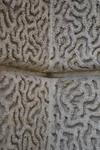Architecture Flashcards
(925 cards)
Descriptive of two figures placed front to front

Affronted
Aisle around the sanctuary of a church.

Ambulatory
Outwork defending the entrance to a castle

Barbican
The italian Renaissance architecture of the 16th century; also used for its 19th-century revival.

Cinquecento
Walling material of clay mixed with straw

Cob or pis
Continuous layer of stones, bricks etc. in a wall

Course
A stained-glass techinque invented in the mid-20th century,setting large, thick pieces of cast glass into a frame of reinforced concrete or epoxy resin

Dalle-de-verre (lit. glass slab)
Rooms in a formal series, usually with all the doorways on axis

Enfilade
A church with nave and aisles of approximately equal height

Hall-church
Bricks, tiles, stones or (sometimes) timbers laid diagonally, usually in superimposed alternate courses

Herringbone work
A girder with braced framework

Lattice girder
A monolithic slab laid flat over a grave or tomb

Ledger slab
The setting of a brass or other inlaid material
Matrix
A style used from c. 1860, in which tile-hanging, tall chimneys, half timbering and other details of the gabled vernacular architecture of south-east England are picturesquely combined

Old English
In a church, a gallery in which the organ is placed

Organ loft
Wide convex moulding

Ovolo
Long straight braces in a timber roof, passing across other members of the truss

Passing braces
Open-ended ground-level passage through a building

Pend (Scots)
On a classical building, a colonnade all round the exterior or an interior space, e.g. a courtyard

Peristyle
Ornamental or pictorial inlay by means of thin slabs of stone

Pietra dura
Mortar joints formed with a trowel so that they stand out

Ribbon pointing
Screen that was placed below a representation of the Crucifixion

Rood screen
A stair in a circular well with a central supporting newel

Spiral stair, vice or turnpike stair (Scots)
Underside of an arch, lintel, etc.

Soffit (lit. ceiling)















































































































































































































































































































































































































































































































































































































































































































































































































